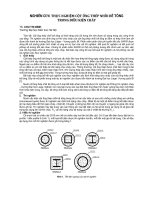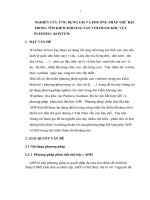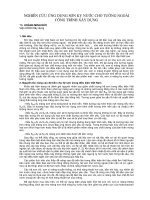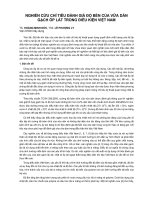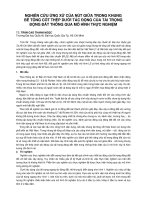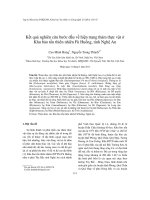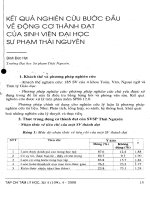BÁO CÁO KHOA HỌC: "Nghiên cứu bước đầu các cây thuốc chữa ung thư ở Việt Nam " doc
Bạn đang xem bản rút gọn của tài liệu. Xem và tải ngay bản đầy đủ của tài liệu tại đây (131.01 KB, 10 trang )
Nghiên cứu bước đầu các cây thuốc chữa ung thư ở Việt
Nam
Từ thời tiền sử con người đã biết sử dụng cây cỏ phục vụ
cuộc sống, 150.000 trong số 250,000 – 300.000 loài thực
vật có hoa ở vùng nhiệt đới đã được sử dụng làm thuốc.
Gần 5 % số cây thuốc đã được nghiên cứu thành phần hóa
học. ở Việt Nam đã có 3870 loài trong số 11.373 loài cây
có hoa, được sử dụng làm thuốc. Để phục vụ cho vấn đề
chữa trị bệnh ung thư các tác giả bước đầu đã thu được kết
quả như sau:
1. Số lượng các loài có khả năng chữa trị bệnh ung thư: 50
loài thuộc 36 chi và 24 họ. Trong số đó, họ Zingiberaceae
là đa dạng nhất (16%), tiếp theo là Myrsinaceae và
Annonaceae (10%).
2. Dạng cây thường là cây gỗ và cây thảo (34%), dây leo
chỉ chiếm 6%.
3. Chúng chủ yếu sống trong rừng (38%), 10% được bắt
gặp ở vùng núi đá vôi. Trong đó, 36% tổng số loài đã được
nhân dân thuần hóa và trồng trong vườn nhà.
Như vậy, trong thiên nhiên, những nguồn tài nguyên về cây
thuốc là khá phong phú và cần được quan tâm. ở đây,
chúng tôi chỉ mới bước đầu điều tra sơ lược về các cây có
khả năng chưa trị bệnh ung thư, căn bệnh mà cả thế giới
hiện nay đang quan tâm.
Note: This paper is completed under the support by the
programme of resaerch of Vietnam National University.
Người thẩm định nội dung khoa học: GS.TSKH. Nguyễn
Văn Trương, Viện trưởng Viện Kinh tế – Sinh thái
INTRODUCTION
Using Plant as drugs has been a goal of mankind since
prehistoric times. Most of drugs in use today have their
origin from plants used by healers since time immemorial.
It is estimated that there are about 250,000 – 300,000
species of flowering plant on this planet of which 150,000
are found in the tropical forests. (Prance, 1977). Less than
5% of these plants have been so far investigated for
pharmacologically active compounds. Higher plants are
untapped reservoirs, only waiting to be investigated. For
many classes of drugs widely employed in humans,
synthesis of novel structures has not yielded entities with
new mechanism of action.
Plants have been used in the treatment of cancer for over
3,500 years (Hartwell, 1967), but it is only since 1959 that
a concerted systematic effort has been made to screen crude
plant extracts for their inhibitory activity against animal
tumor systems. About 11,373 plant species are present
throughout the forests, hills, plains, crop fields, marshy
lands of Vietnam, of which 3870 species reported to be
used in traditional medicines for the health care of the
millions of people of this country (Do Huy Bich et al.
2004).
For long time minority people in Vietnam have been
effectively using traditional medicinal plants. They are
sometimes used as sources of direct therapeutic agents.
With the large number of ethnic minority, Vietnam is
endowed with vast resources of medicinal plants and the
plant may provide lead compounds for the future anticancer
therapy. Some of them have been studied and details
recorded and some are industrial produced and sold. When
Western medicines became more popular, the traditional
medicinal plants were less used. Beside, modern medicine
is limited and the high cost of many modern drugs means
that traditional medicine is the first choice in the case of
having cancer as well as other illness.
OBJECT AND METHODS
This paper sheds light on the anticancer plants used in the
popular herbal remedies. With this objective, 50 different
anti-cancer plant species were collected. They are
suggested for using as sources of starting point for the
elaboration of more complex semi-synthetic compounds.
The research was carried out in the hope of finding out
some new potential plants for modern medicine used in the
treatment of cancer.
The local people were interviewed to obtain certain details
and the specimens were identified and arranged according
to the system of Brummitt, 1992.
- Systematic evaluation of traditional medicinal plants
collected and investigated
- From the list of plants some species are suggested for
analysis and treatment.
RESULTS AND DISCUSSION
Table 1: The list of the families of anti-cancer plant.
There are 50 anti-cancer plants of 36 genera of 24 families
collected. Taxa of medicinal plants are completely diverse
and they are distributed differently in different families.
The most diverse is Zingiberaceae (16%) and the next are
Myrsinaceae and Annonaceae (10%). The greatest numbers
of species are in the genera of Ardisia (5 species) and the
next is Annona and Curcuma (4 species).
Diversity of life-forms of anti-cancer plants
The life-form of all the plant reported are shown in the
table 2 below:
Table 2: Life–form of medicinal species
The anti-cancer plants used as herbs and trees are the most
common (34%), shrubs (26%), and lianas (6%)
Distribution
The distribution of anti-cancer plants in different habitats is
shown in table 3. The distribution of wild anti-cancer plants
are mainly in forest (38%) and then are cultivated plants by
local people (36%).
Table 3: Distribution of anti-cancer plants in different
habitats
Some thinhking and suggestion about pharmaceutical
research and use: The above data are results of servey from
experiences of the people and on the field and they are
systematically gathered. These data are a basis for analysis
on biochemistry, assessement on pharmacology and use in
cure for cancer in the future.
CONCLUSIONS
There are 50 anti-cancer plants of 36 genera of 24 families
collected. Taxa of medicinal plants are completely diverse
and they are distributed differently in different families.
The most diverse is Zingiberaceae (16%) and the next are
Myrsinaceae and Annonaceae (10%).
Life-form of anti-cancer plants consisted 34% of herb, 34%
of tree, 26% of shrub and 6% of liana
The distribution of anti-cancer plants are mainly in forest
(38%). 36% of them are cultivated by local people.
LITERATURE SOURCE
1. Do Huy Bich et al. 2004. Plants and animals used as
medicine in Vietnam. Sci-Techn. Publ. House, Hanoi. Vol
1&2.
2. Vo Van Chi 1997. Dictionary of medicinal plants of
Vietnam. Med. Publ. House, Hanoi. 3. Vo Van Chi, Tran
Hop 2002. Useful plants in Vietnam, Ha Noi
4. Pham Hoang Ho 1999-2000. Plants of Vietnam. Vol
1,2&3, Young Publisher, Hanoi.
5. Phung Ngoc Lan, Nguyen Nghia Thin, Nguyen Ba
Thu 1996. Plant diversity in Cuc Phuong. Agr. Publ.
House, Hanoi
6. Đo Tat Loi 2001. Medicinal plants and drugs of
Vietnam. Sci-Techn. Publ. House, Hanoi
7. Nguyen Nghia Thin 2001. Medicinal plants of Thai
minority of Con Cuong, Nghe An
8. Olayiwola Akerele, Vernon Heywood & Hugh Synge,
1991. Conservation of medicinal plant. Cambridge
university press.
9. Jounal of tropical medicinal plants, 2001. Vol.1
(1&2), 148pp.
10. Jounal of tropical medicinal plants, 2000. Vol.2 (1),
154pp.
